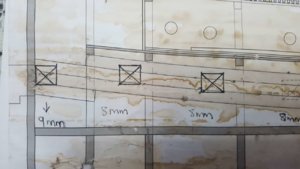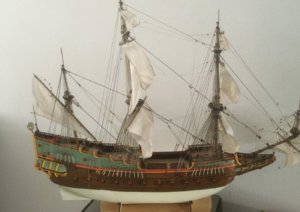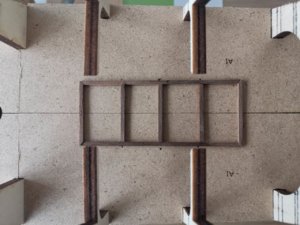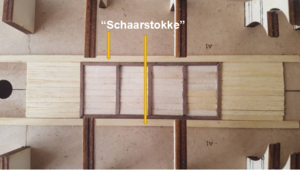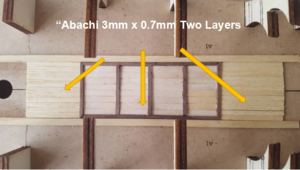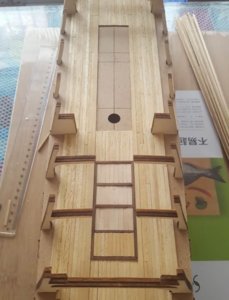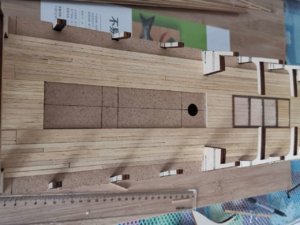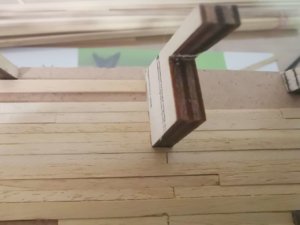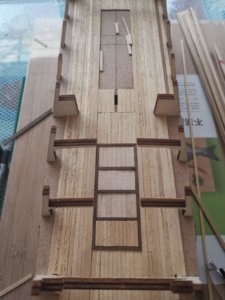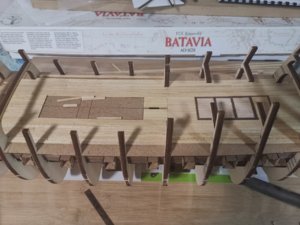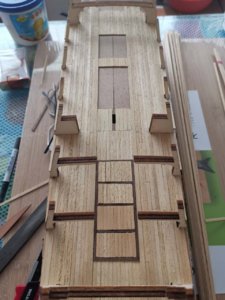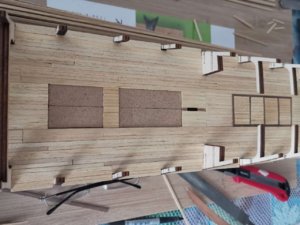Dear SOS Friends
Time for a small update.
My final aim in the next phase is to start the planking process, but these are still a nymber of loose ends that need to be tied up before that can begin.
In my previous post I mentioned that work on the stern is up next. The last three bulkheads of the stern assembly are still only dry-fitted at this stage; so they obviously need to be glued in place first. For this there is a very definite order that needs to be followed. The bottom-most part of the rear spiegel assembly (I have identified this as the “wulf” in one of my previous posts), needs to go in first, then the top part directly above that and lastly the very rearmost part that contains the upper part of the spiegel and the windows.
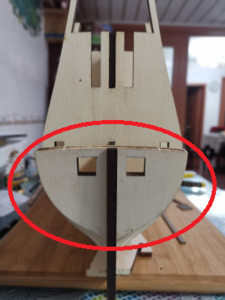
The "wulf" is marked in red.
So first up was the wulf that needs to be planked with 4mm walnut strips at an angle of 72 degrees. After that has been completed, the gunports needs to be cut open - whether they are to be used or not. If the builder’s final choice is to have the gunports closed, they are covered at a later stage with the hatches provided. This is indeed the way that assembly of the Batavia is intended.
Some builders choose to do the planking with the wulf already attached permanently to the ship, but I was not that brave and chose the “easy” way of doing the planking - with the wulf removed from the ship. In retrospect, I suppose this wasn’t really easier, because now I couldn’t simply butt-up the joints against the false keel. With the wulf dry-fiited to the hull, I traced two lines on either side of the keel with a pencil. This area would represent my “keep clear” zone which had to be adhered to at all costs. Cross this line with the planking and the wulf would simply not slide over the keel. So instead of then being forced to remove wood from the keel to necessitate fitment, it was far easier just to keep the “clear zone” CLEAR!
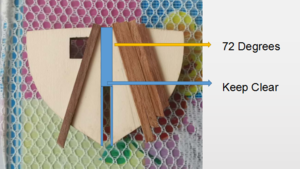
This picture shows the first part of the planking with the "Keep Clear" zone indicated in blue.
With the help of a protractor the correct angle was determined and a few explanatory planks laid down. You will notice that the thickness of some of the planks vary slightly (not much, but perceptible) which I really like in this case. They can obviously be smoothed out during the final sanding and finishing, but for now they create great definition between the planks. Also, i did not pre-select strips of walnut that were close in apperance to one another - I picked them randomly. As Hans from Kolderstok has already noted, the Dutch built ships with whatever was at hand and sometimes it led to a far less structured approach than ... say ... the British.
Once I got planking, I became so engrossed that I completely forgot to take photographs. So, unfortunately, I have no pics of the wulf doing its best rendition of a porcupine! Blame Hans’s
gripping factor that he engineers into his kits for this!
With the planking finished and the glue properly dried, I simply turned the wulf on its other side, clamped it to a cutting board and gave it a proper “haircut” by just tracing repeatedly with a box cutter around the outer edges of the wulf. This went surprisingly easy and I was very happy with the result.
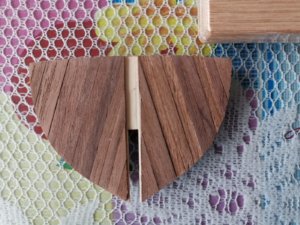
The preliminary finished wulf separate from the ship.
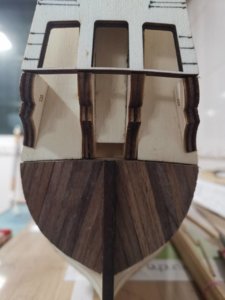
And on the ship.
Then it was time for cutting open the gunports and configuring a way of installing cannon boxes in the very limited space available behind the wulf. And then it dawned ... there was no way that my trusty box cutter cum multi-purpose knife was going to fit into the gunports.
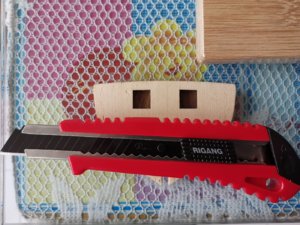
Neither do I possess a chisel with a 5mm (or smaller) cutting face. A visit to my hardware store also did not yield any results. So the only option left is to order an X-Acto knife from Taobao and wait the few days it takes to get delivered.
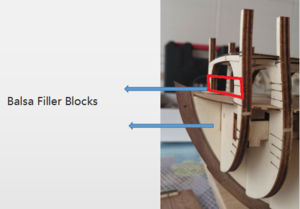
The bow section will need to be filled with balsa blacks which are then shaped into the curvature of the bow to assist when planking. However, these balsa bloks are inserted both below and above the false deck. Below the false deck, the placement is no issue, but to be sure of the exact height that it needs to be filled to above the false deck, I deemed it fit to install the forecastle deck first. As I have now grown accustomed to, the fitment of the Kolderstok decks are tight, but perfect. The decks literally “click” into the position.
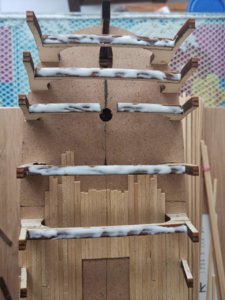
Cross-beams glued to accept the Forecastle.
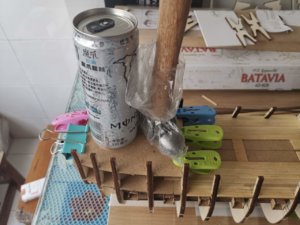
And courtesy of clips, a Monster Energy drink (sorry NASCAR!) and my hammer, the necessary weight is applied to ensure that all areas make contact.
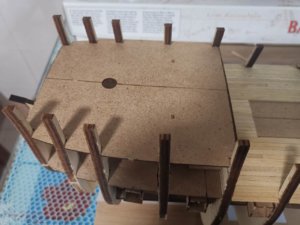
Note the perfect seam between the two halves of the Forecastle - a Kolderstok hallmark.
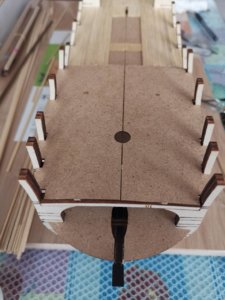
And directly from the front and above.
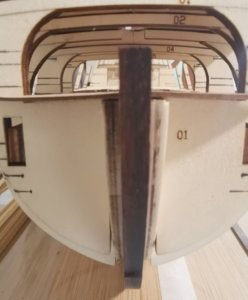
Initially meant to show the alignment of the cross-beams, this picture also revealed something else which I will explain.
With the front deck installed, and me playing around with my camera, I also discovered something that I wasn’t too happy with. When I dry-fitted the quarterdeck (which ends against bulkhead #12 towards the stern), there remains an opening that when viewed from the bow side, offers a clear view of the unfinished area between bulkheads #12 and #14 (see the area in the red block on the photograph).
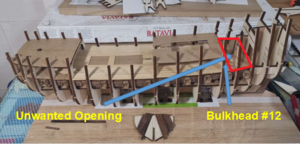
When I viewed one of the earliest build logs of the Batavia, this opening was sealed off with a black-painted “wall” which gave a nice and finished-off look to the deck area below the quarterdeck. Hans informed me that because this area is not really visible with the quarterdeck and gratings in place, this piece has been omitted from later kits. Granted, I agree it is not very visible, but I can see it, and more importantly, I know about it.
I delved into my box of scrap wood and came up with a “beam” which I cut to length, bent into the curvature of the deck, painted black and glued up against the rear of bulkhead #12.
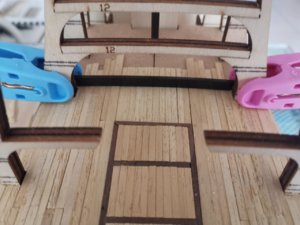
Black-painted beam in place at the bottom of and behind bulkhead #12.
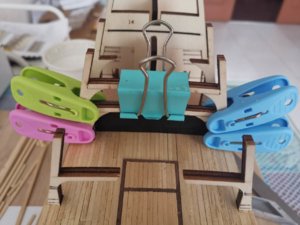
A scrap piece of MDF was then shaped to follow the beam’s curve, painted black and glued on top of the beam and against bulkhead #12. Now I had my black wall, the unfinished area is no longer visible from the front and there is a definitive and clear line from where the planking starts.
As a second-last activity of this update, I also glued the Helm Deck into position to ensure there is an equal amount of stress on the bulkheads front to rear. Ideally I should have fitted the quarterdeck, but the deck still needs to be treenailed, sanded and finished so it is just impractical to cover such a large portion of the desk at this stage.
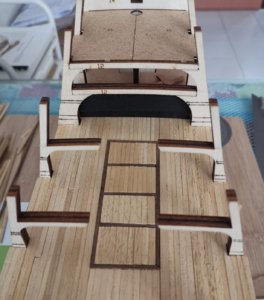
Helmsman's Deck in place.
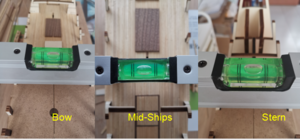
As a final measure the hull alignment and symmetry were checked.
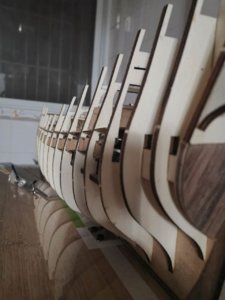
And with that, everything was cleaned and the shipyard closed for this update.
Thank you all for your continued interest and for following - it is much appreciated.
Kind regards - Heinrich

